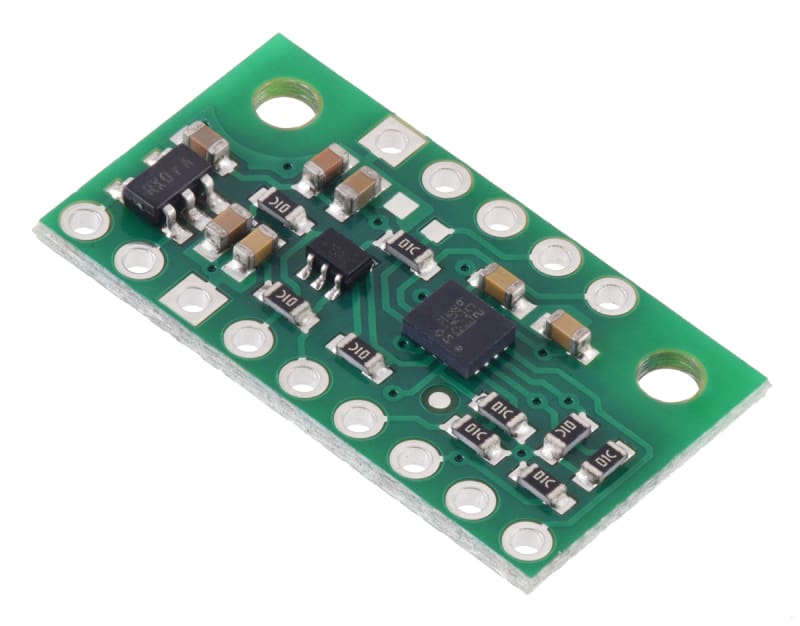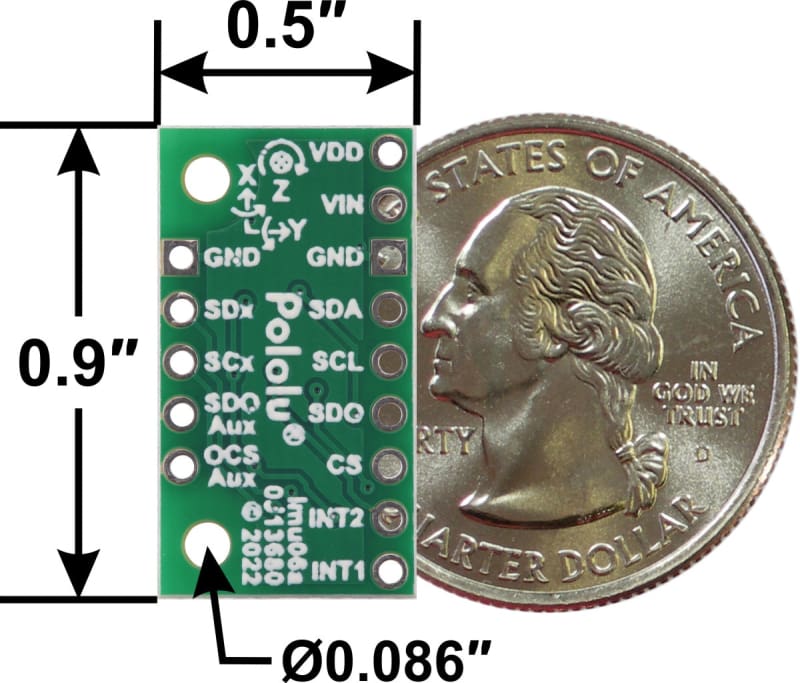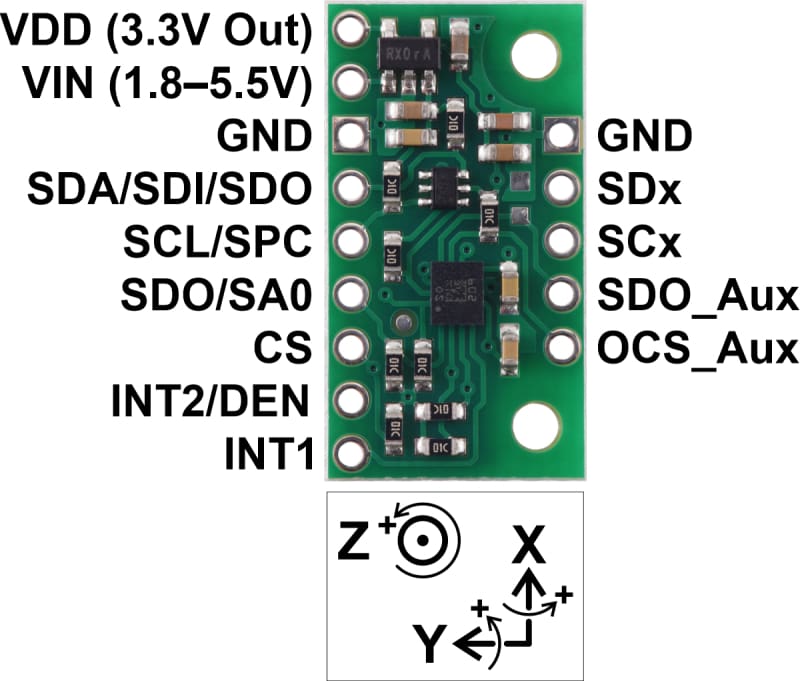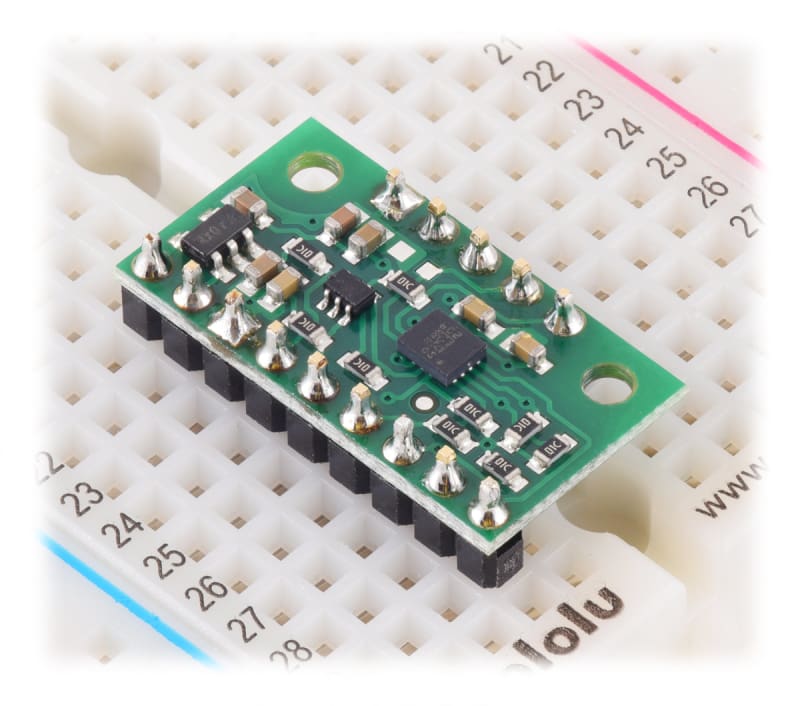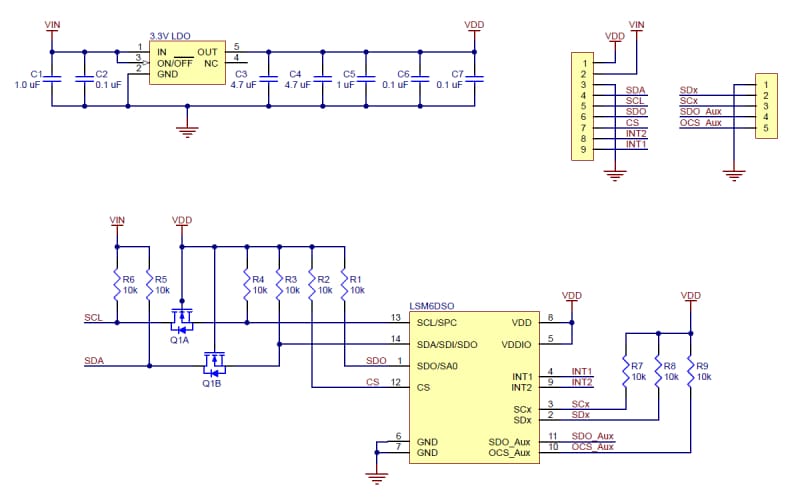LSM6DSO 3D Accelerometer and Gyro Carrier with Voltage Regulator
LSM6DSO 3D Accelerometer and Gyro Carrier with Voltage Regulator is backordered and will ship as soon as it is back in stock.
Couldn't load pickup availability
DESCRIPTION
This board is a compact (0.5″ × 0.9″) breakout board for ST’s LSM6DSO inertial module, which features a 3-axis digital linear accelerometer and 3-axis digital rate gyroscope; we therefore recommend careful reading of the LSM6DSO datasheet (3MB pdf) before using this product. The LSM6DSO is a great IC, but its small package makes it difficult for the typical student or hobbyist to use. It also operates at voltages below 3.6 V, which can make interfacing difficult for microcontrollers operating at 5 V. This carrier board addresses these issues by incorporating additional electronics, including a 3.3 V voltage regulator and level-shifting circuits, while keeping the overall size as compact as possible. The board ships fully populated with its SMD components, including the LSM6DSO.
The LSM6DSO inertial measurement unit (IMU) has many configurable options, including dynamically selectable sensitivities for the accelerometer and gyro, a choice of output data rates, and two independently-programmable external inertial interrupt pins. The accelerometer and gyro can be individually turned on and off to save power. The sensor can be configured and its readings can be accessed through a digital interface, which can be configured to operate in either I²C (TWI) or SPI mode. The MIPI I3C protocol is also supported on the I²C pins.
The six independent acceleration and angular rate readings (sometimes called 6DOF) provide data that a microcontroller or computer can use to calculate the orientation of the LSM6DSO on two axes (roll and pitch; a magnetometer is generally required to compute yaw accurately). With an appropriate algorithm, the gyro can be used to very accurately track rotation on a short timescale, while the accelerometer can help compensate for gyro drift over time by providing an absolute frame of reference.
The carrier board includes a low-dropout linear voltage regulator that provides the 3.3 V required by the LSM6DSO, which allows the sensor to be powered from a 1.8 V to to 5.5 V. The regulator output is available on the VDD pin and can supply almost 150 mA to external devices. The breakout board also includes a circuit that shifts the I²C clock and data lines to the same logic voltage level as the supplied VIN, making it simple to interface the board with 5 V systems. The pins are spaced to work with standard 0.1″ (2.54 mm) male headers and 0.1″ female headers (available separately), making the board easy to use with solderless breadboards and 0.1″ perfboards. The board has two mounting holes that work with #2 and M2 screws (not included).
Compared to the LSM6DS33, the LSM6DSO offers various improvements like lower noise and a higher maximum output data rate for the gyro. In addition to standard operation as an I²C or SPI slave (Mode 1), the LSM6DSO also supports additional specialized modes with a secondary interface: it can act as a master (sensor hub) on a second I²C bus (Mode 2), or it can provide an auxiliary SPI slave interface that is useful for electronic and optical image stabilization (EIS/OIS) applications (Mode 3/4). See the datasheet and application note (2MB pdf) for more information about these modes. Our carrier board brings out these secondary interface pins on the side opposite the main connections.
This LSM6DSO carrier is pin-compatible with our earlier LSM6DS33 carrier (and many of our other ST I²C/SPI sensor carriers), and the orientation of the sensor axes is the same. The ICs also use the same I²C address and have similar register interfaces, so code written to interface with the LSM6DS33 can probably be modified to work with an LSM6DSO without too much trouble.
FEATURES
- Dimensions: 0.5″ × 0.9″ × 0.1″ (13 × 23 × 3 mm)
- Weight without header pins: 0.6 g (0.02 oz)
- Operating voltage: 1.8 V to 5.5 V
- Supply current: 1 mA
- Output format (I²C/SPI):
- Accelerometer: one 16-bit reading per axis
- Gyro: one 16-bit reading per axis
- Sensitivity range (configurable):
- Accelerometer: ±2, ±4, ±8, or ±16 g
- Gyro: ±125, ±245, ±500, ±1000, or ±2000°/s
RESOURCES
File downloads
-
LSM6DSO datasheet (3MB pdf)
-
AN5192: LSM6DSO application note (2MB pdf)
This application note from ST provides usage information and application hints for the LSM6DSO accelerometer and gyro.
-
UM10204 I²C-bus specification and user manual (1MB pdf)
The official specification for the I²C-bus, which is maintained by NXP.
-
Schematic diagram for the LSM6DSO 3D Accelerometer and Gyro Carrier with Voltage Regulator (100k pdf)
-
Dimension diagram of the LSM6DSO 3D Accelerometer and Gyro Carrier with Voltage Regulator (1MB pdf)
-
3D model of the LSM6DSO 3D Accelerometer and Gyro Carrier with Voltage Regulator (4MB step)
-
Drill guide for the LSM6DSO 3D Accelerometer and Gyro Carrier with Voltage Regulator (20k dxf)
This DXF drawing shows the locations of all of the board’s holes.
Recommended links
-
An Arduino library for interfacing with the LSM6DSO and LSM6DS33 accelerometer and gyro ICs.

